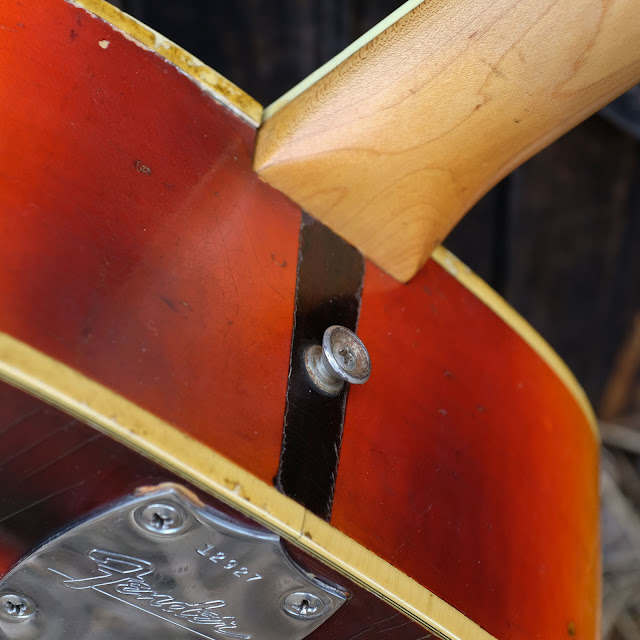1966 Fender Kingman Electrified Dreadnought Guitar
I really do love old, US-made Fender acoustics. They have all sorts of great ideas that seemed to go nowhere in the market, though many imports began using similar bolt-on necks in the '70s. They also have a very individualistic voice. To my ears, they have a lot of clarity and punch backed with just enough rumble and ka-chunky lower-mids to fill them out. This old Kingman sounds a bit like a J-200 but with more of an archtop-style attack when you're chopping on it. Keep in mind that the soundclip doesn't do it 100% justice because the strings are nickel 49w-11s and not a proper set of 54w-12s. The lightly-gauged wound G string is a little zingy, too, as it's fresh.
This guitar was owned by a friend-of-a-friend who passed away last year. This friend of mine brought it in to get it spruced-up and an electric soundhole pickup installed. He had a couple of electric pickups yanked off of an old '60s Kay archtop, but when I fitted one to try it out it just felt woofy and muddy for this application. A friend of mine had deposited an '80s/'90s Bill Lawrence archtop pickup in my parts-bin and so I thought of that, tested it out, and said, "that's the ticket!" I made a custom bracket for it and wired it up and installed that, instead. It's a much nicer fit and closer in vibe to the "original factory-issued" DeArmond-style soundhole pickups that many old Fender Kingman guitars came with in the '60s.
Other work included a fret level/dress, a number of cleats and fill/seal jobs to bad top hairline cracks, lots of cleaning, replacement bridge pins, a replacement string tree, a replacement pickguard, and a good setup. It plays perfectly, now, and the Strat-like, slick-feeling neck is icing on the cake. I can barre an E chord (with the F-shape) up at the 12th fret and not feel cramped. It's wild how these work playability-wise.
Specs are: 25 1/2" scale, 1 5/8" nut width, 1 1/4" nut string spacing and 1 15/16" bridge spacing, 15 5/8" lower bout width, 11 5/8" upper bout width, and 4 1/4" side depth. It sits much like a J-45 in the lap and the body splits the difference between a Martin-style square-shouldered outline and a Gibson-style round-shouldered outline. The slightly-shallower depth compared to many dreadnoughts also makes it a little comfier on the right-arm.
The big-block pearloid sure makes an impression.
I used an old machinist's rule to make the bracket that holds the pickup in place. Note how shot the top on this guitar is -- it's had a lot of rough use over its life. The pickguard is a new one I cut for it and I traced it off of a pattern I made of an original from another Fender acoustic.
I love this adjustable bridge. Its only failing is that the back wall of the rosewood that holds the screws should be just a little bit thicker. This bridge was also reglued very sloppily sometime in the past, though the glue-job is still holding-up.
It'd be neat to see what a modern version of this type of adjustable bridge might look like -- using Tusq offset Tele-style saddles, maybe, so they're height-adjustable, too?
While the top is solid spruce, the back and sides are ply, flamed maple. How about that?
The Fender "F" tuners are still going strong.




















Comments